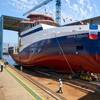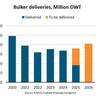The Port of Houston Authority Commissioners voted recently to appeal the U.S. District Court's January 25 ruling that the Port should pay for the removal and relocation of pipelines to accommodate the widening and deepening of the Houston Ship Channel. "We believe Congress clearly specified in 1996 that pipeline owners, not the taxpayers of Harris County, should pay for the removal and relocation of pipelines needed to widen and deepen the Ship Channel," said Port Chairman James T. Edmonds. "The companies operating terminals along the Ship Channel are the primary beneficiaries of these Ship Channel improvements, and we believe -- with Congress and the U.S. Army Corps of Engineers -- that these companies, and not the public, should pay for the pipelines removal."
The Port of Houston Authority owns and operates the public facilities along the Port of Houston, a 25-mile-long complex of diversified public and private facilities that handle more than 175 million short tons of freight worth more than $60 billion annually. The Port Authority plays a vital role in ensuring navigation safety along the Houston Ship Channel, a key economic catalyst for the city since the Port of Houston first opened to deep-water vessels in 1914. The Port is the source of more than 200,000 direct and related jobs
and generates about $525 million annually in state and local taxes. The Port of Houston ranks first in the U.S. in foreign waterborne commerce and second in total tonnage. Each year, more than 7,000 vessels from around the world call at the Port.
The Houston Ship Channel is being deepened to 45 feet from its current depth of 40 feet, and widened to 530 feet from 400 feet, in order to safely move and efficiently handle large international cargo ships. In 1989, the voters authorized the Port's participation in the widening and deepening project.
To make way for the deepening and widening, 87 pipelines that carry a variety of materials including chemicals and crude oil must be removed. The pipeline owners have indicated that in many cases, they want to relocate the pipelines under the Ship Channel. The United States Army Corps of Engineers, which is implementing the project, estimated that the cost to remove and relocate the pipelines will exceed $100 million.
History of the Dispute
In 1996, the U.S. Congress authorized the deepening and widening project in accordance with a feasibility study the Corps prepared. That study required the owners to pay for the cost of removing and relocating the pipelines. In 1998, pursuant to powers granted it by Congress, the Corps told the pipeline owners to move the pipelines.
In November 1998, the pipeline owners, rather than bear the costs of moving and relocating the pipelines themselves, sued the United States Army Corps of Engineers and the Port of Houston Authority asking the Court to require the Port and the taxpayers to pay for the pipeline removal and relocation.
On January 25, 2002, a U.S. District Judge ruled for the pipeline owners and against the Corps and the Port. The Judge ordered that the letters the Corps sent the pipeline owners requiring them to pay for the pipeline removal be amended to require the Port to pay for the removal and relocation.
MarAd Releases Ports Report
The new report from MarAd contains summary tables that present a profile of calls at U.S. ports in terms of active fleet characteristics (vessel type, age and size), and a 3-year time series of calls at U.S. ports by vessel type. Detailed tables present calls at major (top 50) ports, by vessel type and size. The report highlights, for example, that 48 percent of the active world fleet called at a U.S. port during 2000, and that the top 20 U.S. ports accounted for 77 percent of the overall vessel capacity calling at U.S. ports. (The top 5 accounted for 49 percent.) Reflecting a certain level of regional specialization, tanker and dry bulk vessel calls tend to be concentrated at Gulf ports, while containership calls are heaviest at Atlantic and Pacific ports. Overall, the average size of vessels calling at U.S. ports was 14 percent larger than the world fleet average. For the period 1998 to 2000, calls at U.S. ports by vehicle carriers increased by 46 percent, reflecting both an increase in U.S. vehicle imports and higher call frequencies. Containership calls at U.S. ports increased by 6 percent from 1998 to 2000, but containership capacity calling at U.S. ports increased by 12 percent, reflecting an increase in average vessel size. Copies of the report, which was prepared by MARAD's Office of Statistical and Economic Analysis may be obtained in printed format from that office by calling (202) 366-2267 or by accessing the agency's web site: http://www.marad.dot.gov, under Publications & Statistics, follow link to Port Statistics.
Sponsored Content
Safer Starts Here: Build Ships, Protect Crews

Subscribe for
Maritime Reporter E-News
Maritime Reporter E-News is the maritime industry's largest circulation and most authoritative ENews Service, delivered to your Email five times per week









